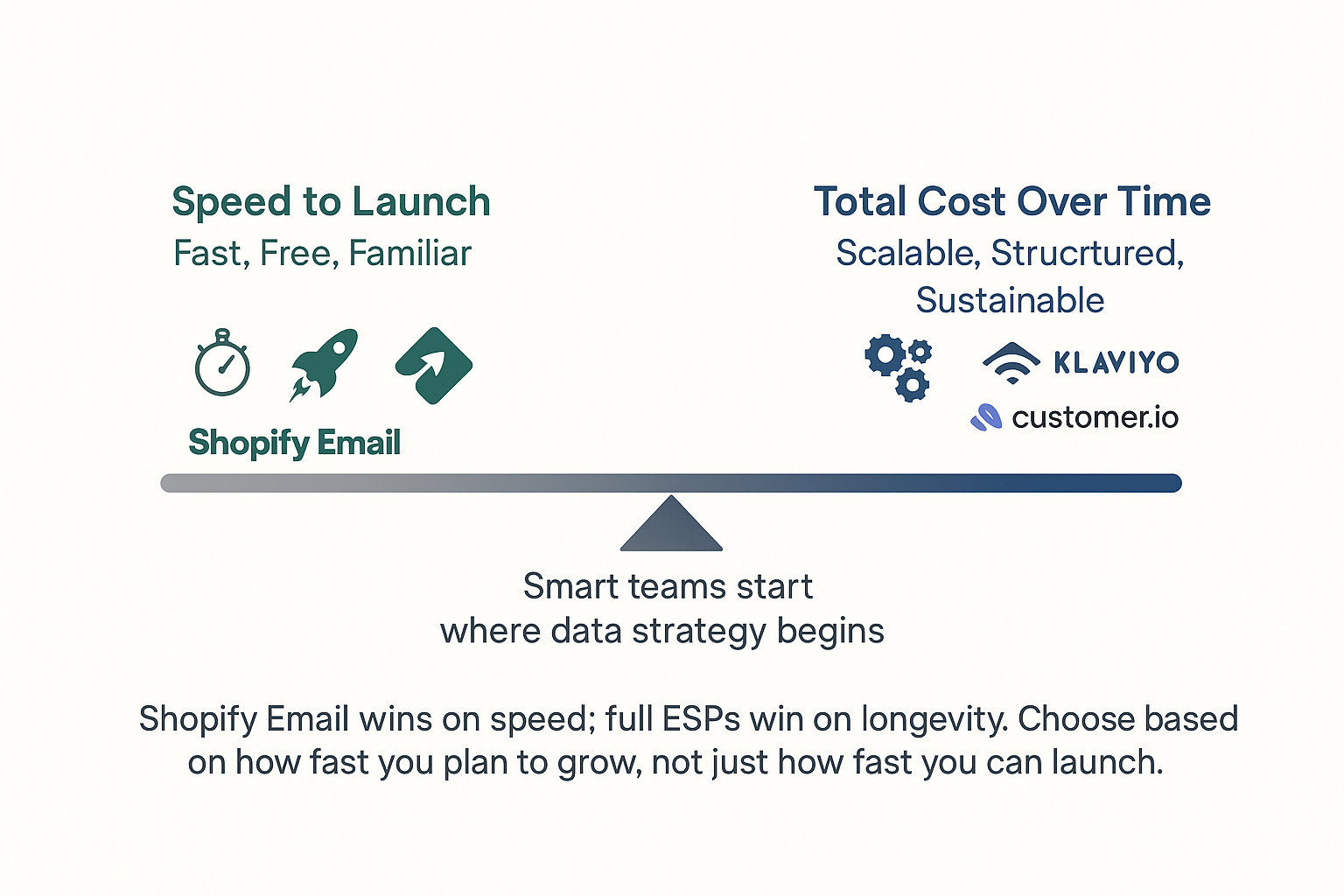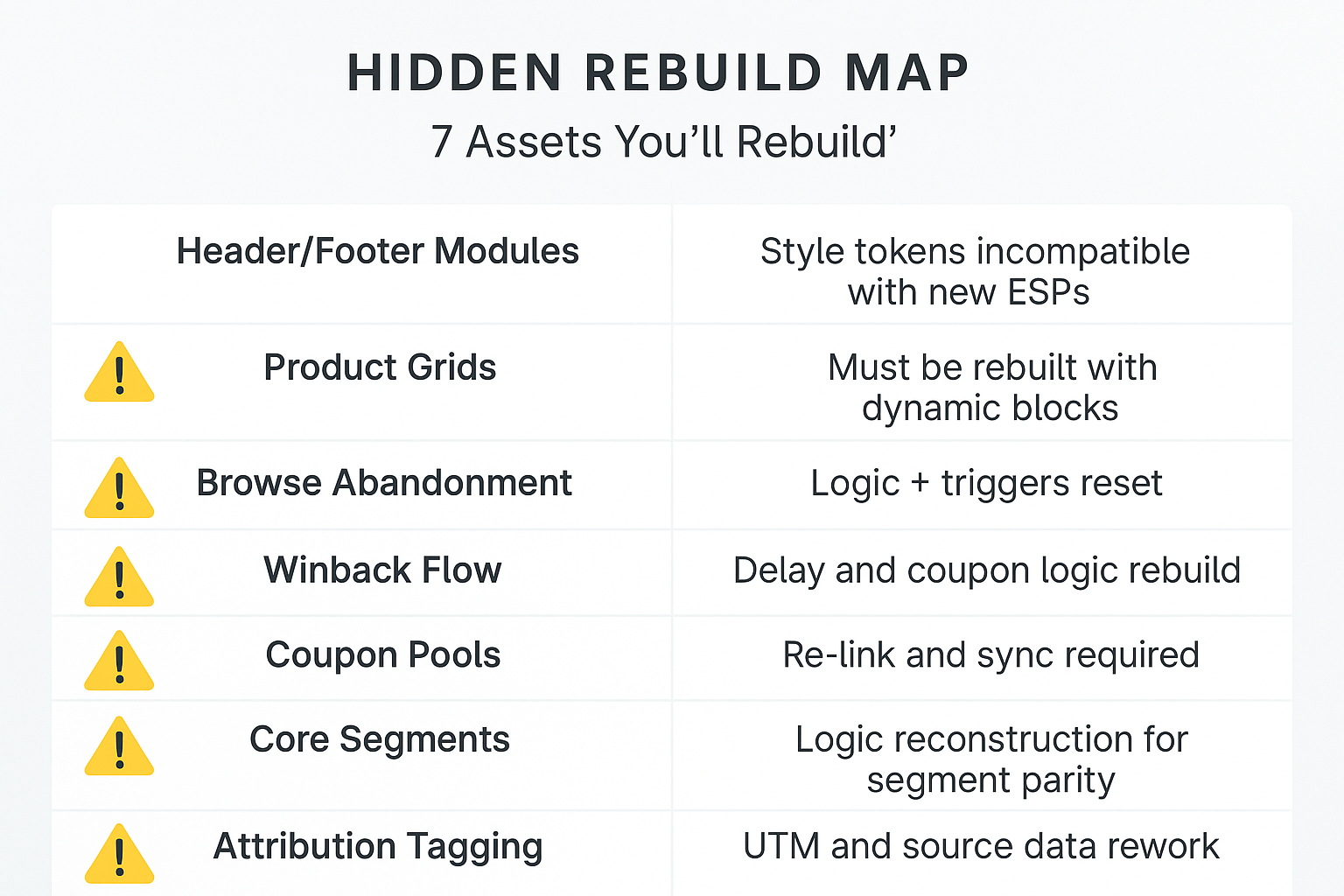The Founder’s Dilemma — “Ship Now on Shopify Email, Upgrade Later?”
It’s a decision every new brand faces: start with Shopify Email or Klaviyo, or go all-in on a more powerful ESP from day one. This section explores the hidden tradeoffs behind that choice—and how it impacts your timeline, tech debt, and marketing velocity.
Shopify Email is tempting for a reason: it's free, native, and gets you sending fast. For early-stage stores or MVPs, that might be enough.
But the tradeoff isn’t just about features—it’s about future cost. Most teams underestimate the asset and data debt they build up when they migrate from Shopify Email later. What saves money now can burn time (and revenue) down the line.

What “Rebuilding Twice” Actually Means (Hidden Cost Map)
Migrating off Shopify Email later isn’t a simple copy-paste job. Most assets—from templates to tracking—need a full template rebuild, often under time pressure. Here’s a breakdown of what that rework actually looks like.
Behind every fast start is a hidden rebuild. Shopify Email uses its own style tokens, template formats, and logic structures—almost none of which cleanly port to Klaviyo, Customer.io, or Omnisend.
You won’t just be redoing emails. Achieving flow parity means rebuilding triggers, delays, coupon logic, and eligibility rules from scratch. And if your segments were built natively in Shopify, you’ll likely need to reconstruct logic to reach segment parity in your new ESP.
The result? Teams doing the same work twice—only the second time under a migration deadline.
The 7 assets most likely to be rebuilt from scratch: header/footer modules, product grids, browse abandonment, winback flow, coupon pools, core segments, and attribution tagging.

Where Shopify Email Is Fine (and Where It’s a Ceiling)
Shopify Email works well for lightweight needs—but many teams outgrow it fast. This section outlines the signs you're bumping into its limits, and when it's time to consider upgrading.
Shopify Email can absolutely carry a brand—for a while. It’s solid for simple newsletters, small catalogs, and basic abandonment flows.
But in the Klaviyo vs Shopify Email conversation, the difference shows up fast when you need more than the basics. Predictive segments, split testing, SMS orchestration, or locale-based journeys all fall under behavioral email automation—and that’s where Shopify Email starts to hit ceilings.
The moment your ops team is spending more time hacking workarounds than launching strategy, it’s time to move up.
Cost Model — “Free Now” vs “Pay Later”
Shopify Email has no monthly fee, but that doesn’t mean it’s free. The real cost shows up later—in email migration costs, rebuild hours, deliverability risks, and testing friction. This section helps you run the numbers clearly.
That $0 line item looks great—until you factor in the true total cost to operate: rebuild hours, QA cycles, and missed revenue from delayed segmentation or personalization.
If you start with Shopify Email and migrate later, expect 1.5x–2x the effort to reach functional parity. In many cases, early access to smarter targeting more than pays for the upgrade—long before the bill comes due.
.png)
Data & Events — Don’t Paint Yourself Into a Corner
What you track now affects what you can automate later. If you don’t capture clean events and stable IDs today, you’ll limit your future segmentation, suppression, and reporting flexibility.
You may not need full warehouse activation on day one—but you do need clean, portable data. That starts with an intentional identity strategy (email vs customer_id) and thoughtful event modeling. Golden events like order_placed, viewed_product, and subscription_status should be structured and logged consistently.
And if you plan to scale into a CDP or data warehouse later, setting up proper events now makes that evolution smoother. With the right structure in place, reverse ETL becomes a lever—not a lift—for activating richer, more personalized campaigns.
Deliverability & Tracking — Protect Reputation Before You Migrate
A good sender reputation isn’t automatic—it’s earned over time. Starting early with domain authentication and clean list practices can prevent major headaches when it’s time to migrate.
Even if you’re on Shopify Email, get ahead of the curve: authenticate your domain (SPF, DKIM, DMARC) now. When you switch ESPs, your sender reputation can carry over—if you’ve laid the groundwork properly.
Your deliverability warmup starts long before migration. Track list hygiene from day one: remove role-based emails, suppress cold cohorts, and apply consistent UTM structures. It’ll protect your IP, improve inbox placement, and save hours of troubleshooting later.
Smart Starter Setup (If You Must Begin on Shopify Email)
If Shopify Email is your launchpad, be intentional about how you build. A few smart decisions—like reusable blocks and consistent naming—can cut your future migration time in half.
If you’re set on starting with Shopify Email, fine. But be strategic.
Build portable design modules, standardize naming (segments, tags, UTMs), and document your required attributes/events in a short data contract. Capture consent metadata properly—it’ll save your legal and ops teams weeks later.
Migration Blueprint — 14-Day Cutover Without the Slump
Migrations don’t have to mean chaos. With a clear migration plan, you can switch platforms in two weeks—without deliverability hits, broken flows, or lost revenue.
Here’s how to migrate to Klaviyo, Customer.io, or Omnisend without blowing your momentum:
- Freeze flows + content ~1 week out
- Export segments, templates, coupon logic
- Prioritize suppression import and count validation
- Rebuild top 10 emails + core flows
- Ramp up send volume with high-engagers
- Backfill flows only with limits to avoid spikes
Treat this like a system migration, not a marketing handoff. The more disciplined your migration plan, the faster your new platform pays off.
Decision Tree — Start on Shopify Email or Go Straight to ESP?
Not every team should start with Shopify Email—and not every team should skip it. This section offers a decision framework based on your catalog complexity, marketing channels, team capacity, and roadmap.
The real question is this: should you start with Shopify Email or Klaviyo?
If you have more than one of the following—subscriptions, multi-store/catalogs, multi-channel marketing (SMS, Ads), or plans to adopt a warehouse or CDP—you’re likely better off starting with a more robust ESP from day one.
FAQ
Still unsure if switching platforms is worth it—or when to make the leap? These common questions cover timing, deliverability, data needs, and more.
Can we port templates from Shopify Email to Klaviyo “as is”?
No. You’ll need to rebuild them using Klaviyo’s template editor or import the HTML and re-style it.
How long does a typical Shopify → ESP migration take?
Plan for 2–4 weeks depending on flow complexity and template volume.
Do we need a warehouse/CDP before moving off Shopify Email?
No, but it helps. ESPs like Klaviyo or Customer.io can work standalone and scale into your data stack.
Will migration hurt deliverability?
Not if you warm up properly and mirror suppressions before sending.
